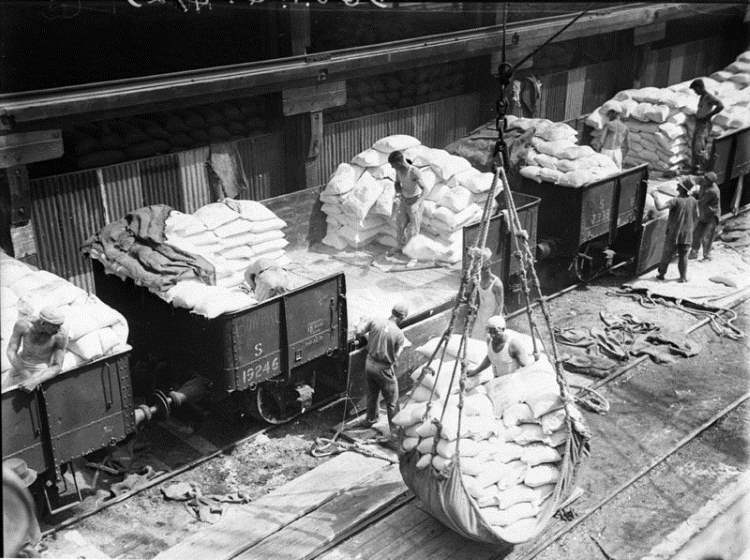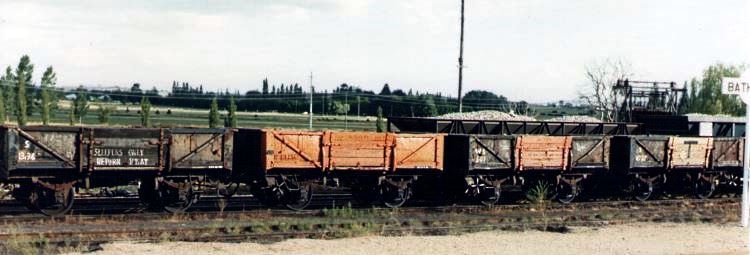NSWGR S Wagons
For over 30 years the most commonly seen goods wagon in NSW was the NSWGR S wagon.
10,000 of them were built between 1945 and 1958 and 100 of them were the last 4 wheel goods wagon in use in NSW.
The S code for a 4 wheel open wagon was in use from as early as 1907 when the coding was applied to a 4 wheel all-steel open wagon.
This original series of wagons entered service between 1907 and 1921 but by the early to mid-1940s the original wagons had all apparently been written off because the S code was then applied to a new wood / steel composite wagon that was ordered from a combination of 2 suppliers.
The NSWGR let the contract for these wagons to Commonwealth Engineering and Clyde Engineering with the steel underframes to be built by Commonwealth Engineering and Clyde Engineering to provide the bodies.

Darling Harbour 1934 and bagged wheat is being unloaded from a string of steel-bodied S wagons. (Photo courtesy of NSW State Library)
In revenue service
These wagons were used throughout the State to carry just about anything that would fit in an open wagon. I’ve seen them carrying beer kegs, hay bales, farm machinery, steel coils, sleepers, gravel, coal and more.
During the period that the composite S wagons were in use you would have been hard pressed to see a mainline or branchline general goods train that did not include at least several S wagons.
Depending on where the train was headed you might see S wagons sprinkled throughout the train as they would have been marshalled for different stations and you could have also seen blocks of S wagons too.
At one time there was a goods train that left Sydney on weekday afternoons that was comprised of nothing but S wagons destined for a number of destinations on the South. The late Ken Groves wrote that this train was not a favourite for most crews for a variety of reasons that Thomas the Tank Engine would well understand.

The end of an era
Although 10,000 S wagons were originally built only 6,826 remained in service in 1970 but you still saw them everywhere. When John Beckhaus’s second book on Railway Freight Wagons in New South Wales was published in 1982 only 1,607 wagons remained in service.
The end of S wagons came not long after that book was published when all 4 wheel stock was phased out but even then a number of S wagons remained in service after all the other 4 wheel stock has been withdrawn.
At that time the Public Transport Commission had a contract to transport coiled steel rod between Port Waratah in Newcastle and Ashfield in Sydney. 100 S wagons were in use and remained in use because the unloading facilities at Ashfield required wagons to have low sides and the only wagons that fitted that limitation were the humble S wagons.

A string of S wagons in departmental service stand in the yard at Bathurst in the early to mid-1980s. The second wagon from the left is listed in the W roster and the colour is not the usual yellow seen on these wagons.
Other uses
Over the years a number of S wagons passed into Departmental use on the L and W rosters and these wagons were usually painted a different colour to the standard NSWGR S wagons. Yellow seemed to be the main colour used on these wagons although I have seen other colours used from time to time.
Other NSWGR S wagons were converted for other purposes. 11 wagons had movable partitions fitted to the interior of the wagon for carrying oil drums or similar containers. These wagons were classified as SO wagons.
9 wagons … some from the ranks of S wagons … had their bodies removed and replaced with timber decks and used as flat wagons. These wagons were classified as BF.
There were 2 wagons classified as CS that had special fittings that allowed them to carry small cylindrical Fielder’s Starches liquid glucose containers.
7 wagons were classified as SWF and fitted with a cradle for carrying wheels and axle sets.
Not all wagons in these last three classes came from the ranks of S wagons. Some were originally 4 wheel vans but all possessed 10’ wheelbases and 18’ long underframes.
The model
While there are several models available on the market today and S wagon makes a fairly easy modelling project for anyone who wants to try their hand at scratchbuilding.
Of course the starting point has to be the underframe but Peco offer a number of wagons with a 10’ wheelbase and over the years I’ve built a number of S wagons in N scale using a Peco underframe as a starting point.
Painting and lettering
The standard colour for S wagons in revenue service was black which quickly weathered to a dark shade of grey.
I’ve always found that Tamiya’s German Grey is a fair representation of the colour of an S wagon that has seen a few years’ service since its last overhaul.
There was never one single block of numbers that covered all S wagons. The lowest numbered S wagon I’ve seen was number 3 while the highest that I’ve seen recorded was 25050
Technical Details
Length: 5.49m (18’)
Width: 2.92m (9’ 7”)
Height: 2.13m (8’ 4.5”)
Capacity: 16 tonnes (15 tons)
The sides were 1m (3’) high with a 2.13m (7’) centrally located door that folded down.
References:
Beckhaus, J 1970, Railway Freight Wagons of New South Wales. SCR Publications, Rushcutters Bay, New South Wales.
Beckhaus, J 1982, Railway Freight Wagons in New South Wales 1982. Australian Railway Historical Society, New South Wales Division, St James, New South Wales .
Veasey, David 1992, Locomotive Hauled Wagons of the New South Wales Government Railways, unpublished (a listing of numbers carried by wagons in service on the NSWGR)